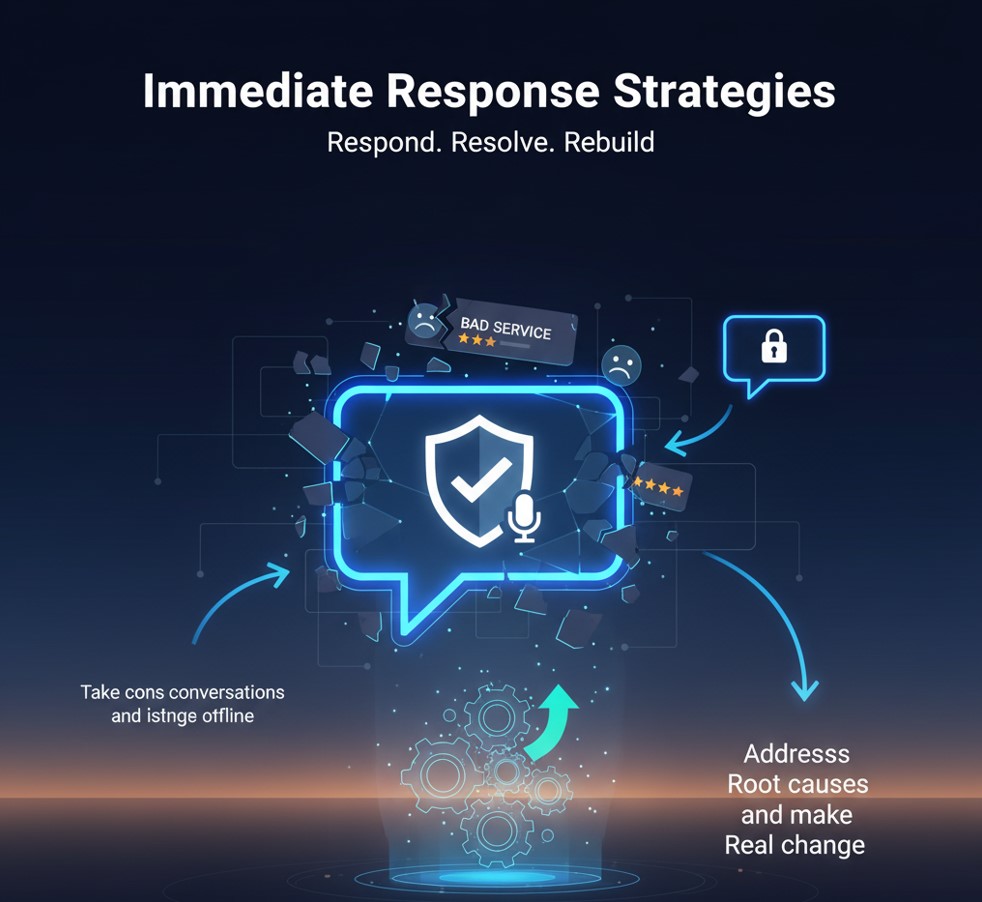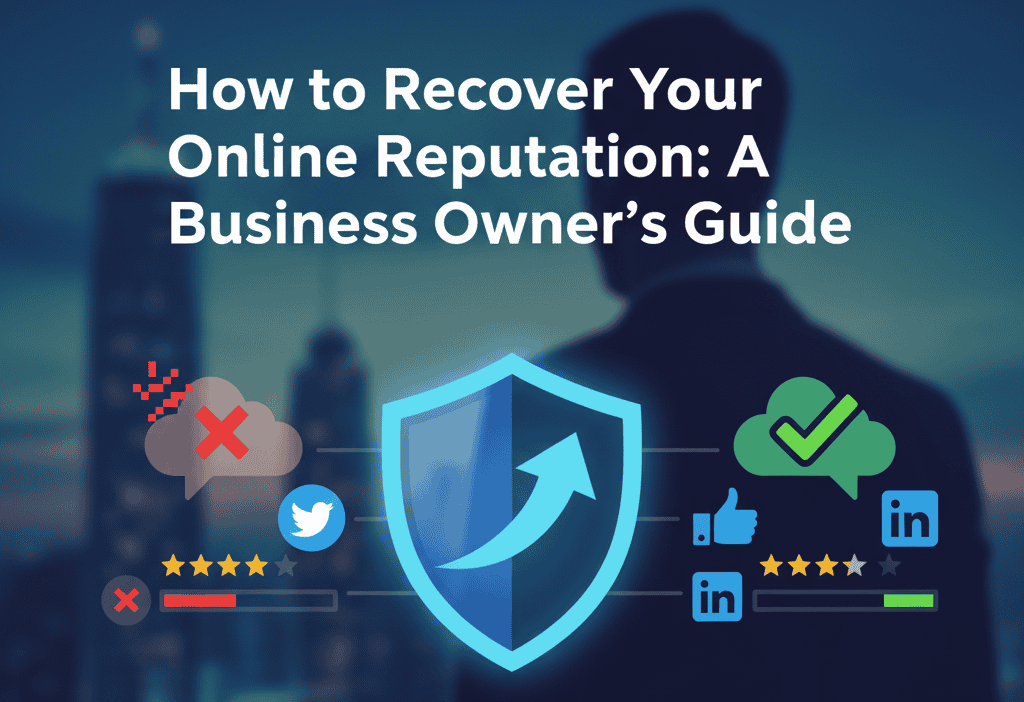Your business’s online reputation can make or break your success. A single negative review, social media mishap, or unflattering news article can spiral into a crisis that affects customer trust, employee morale, and your bottom line. The good news? Online reputation damage isn’t permanent, and with the right strategy, you can rebuild trust and restore your brand’s credibility.
This comprehensive guide will walk you through proven methods to recover from reputation damage, prevent future issues, and emerge stronger than before. Whether you’re dealing with a recent crisis or preparing for potential challenges, these actionable strategies will help you take control of your online narrative.
Understanding Online Reputation Damage
Online reputation damage occurs when negative content about your business gains visibility across search engines, social media platforms, review sites, or news outlets. This can stem from various sources: dissatisfied customers leaving scathing reviews, former employees sharing negative experiences, competitors spreading false information, or genuine business mistakes that went public.
The impact extends beyond hurt feelings. Studies show that 90% of consumers read online reviews before visiting a business, and a single negative review can drive away up to 22% of potential customers. For businesses, this translates directly into lost revenue, decreased market share, and difficulty attracting top talent.
Modern consumers have unprecedented power to share their experiences instantly with thousands of people. A frustrated customer can post a complaint on social media that reaches their entire network within minutes. Search engines amplify this effect by indexing and ranking this content, potentially making negative information the first thing prospects see when they search for your business.
Assessing the Damage
Before developing a recovery strategy, you need a clear picture of what you’re dealing with. Start by conducting a comprehensive audit of your online presence across all major platforms and search engines.
Begin with a Google search using your business name, key executives’ names, and relevant industry keywords. Document everything that appears on the first three pages of results, paying particular attention to negative content. Use Google’s “News” and “Images” tabs to check for unfavorable coverage or problematic visual content.
Expand your search to review platforms like Yelp, Google My Business, Trustpilot, and industry-specific review sites. Social media platforms require separate attention—check Facebook, Twitter, LinkedIn, Instagram, and any platforms where your industry maintains a presence. Look for negative posts, comments, or discussions about your brand.
Create a spreadsheet documenting each piece of negative content, including the URL, platform, date posted, and a brief description. Rate each item’s potential impact on a scale of 1-10, considering factors like the platform’s authority, the content’s visibility in search results, and how many people might see it.
This audit serves as your baseline and helps prioritize which issues need immediate attention versus those that can be addressed over time.
Immediate Response Strategies
When facing reputation damage, your initial response sets the tone for the entire recovery process. The key is acting quickly while avoiding reactive decisions that could worsen the situation.

Respond Promptly and Professionally
Address negative reviews and comments as soon as possible, ideally within 24 hours. A quick response shows you’re attentive to customer concerns and committed to resolving issues. Keep your responses professional, empathetic, and focused on solutions rather than excuses.
Avoid defensive language or arguments, even when facing unfair criticism. Instead, acknowledge the customer’s concerns, apologize for their negative experience, and offer to discuss the matter privately to find a resolution. This approach demonstrates maturity and customer focus to both the original complainant and future readers.
Take Conversations Offline
When responding to public complaints, provide contact information and invite the customer to continue the conversation privately. This serves two purposes: it shows your commitment to resolution while preventing further public escalation of the issue.
Address Root Causes
If the negative feedback highlights legitimate business problems, take immediate steps to fix them. Whether it’s improving customer service training, updating policies, or addressing operational issues, demonstrating real change helps rebuild credibility.
Long-Term Recovery Tactics
Sustainable reputation recovery requires consistent effort over months or years, depending on the severity of the damage. These long-term strategies focus on building positive content and improving your overall online presence.

Content Creation and SEO
Develop a robust content strategy that positions positive information about your business prominently in search results. Create valuable blog posts, case studies, success stories, and thought leadership articles that showcase your expertise and positive impact.
Optimize this content for search engines using relevant keywords that people might use when searching for your business. The goal is to push negative content lower in search results by creating authoritative, positive content that ranks higher.
Consider creating dedicated pages addressing common concerns or highlighting your company’s values and commitments. These pages can rank well for searches related to your business and provide context that counterbalances negative information.
Building Positive Reviews
Systematically encourage satisfied customers to leave reviews on major platforms. Implement post-purchase email sequences asking for feedback, train staff to request reviews during positive interactions, and make the review process as simple as possible for customers.
Focus on platforms where negative content appears, but don’t neglect other major review sites. A strong foundation of positive reviews provides context for occasional negative feedback and demonstrates consistent customer satisfaction.
Social Media Engagement
Maintain an active, positive social media presence across relevant platforms. Share valuable content, engage with followers, and showcase your company culture and values. Regular positive activity helps dilute the impact of negative content and demonstrates ongoing business vitality.
Use social media to highlight customer success stories, community involvement, and behind-the-scenes content that humanizes your brand. This authentic content helps build emotional connections with your audience.
Public Relations and Thought Leadership
Establish yourself and key team members as thought leaders in your industry through speaking engagements, podcast appearances, and guest articles. Positive media coverage and industry recognition help rebuild credibility and create authoritative content that ranks well in search results.
Consider partnering with industry publications, participating in community events, or sponsoring relevant causes that align with your values. These activities generate positive publicity and demonstrate your commitment to your industry and community.
Working with Online Reputation Management Companies
For severe reputation damage or when you lack internal resources, professional reputation management companies can provide valuable assistance. These firms specialize in suppressing negative content, creating positive content, and managing ongoing reputation monitoring.
When evaluating potential partners, look for companies with proven track records, transparent pricing, and ethical practices. Avoid firms that promise unrealistic results or use questionable tactics that could backfire.
Good reputation management companies offer comprehensive services, including content creation, SEO optimization, review management, social media strategy, and crisis communication planning. They should provide regular reporting and maintain open communication about their strategies and progress.
Legal Considerations
While most reputation recovery efforts focus on marketing and communication strategies, legal options may be appropriate in certain situations. If you’re dealing with defamatory content, fake reviews, or competitors spreading false information, consult with an attorney specializing in internet law.
Legal action should be considered carefully, as it can be expensive, time-consuming, and sometimes generates more negative publicity. However, legitimate legal remedies exist for truly defamatory or fraudulent content.
Some platforms have policies against fake reviews and may remove content that violates their terms of service. Understanding these policies and properly reporting violations can sometimes resolve issues without legal intervention.
Prevention Strategies
The best reputation management strategy is preventing problems before they occur. Implement systems and processes that reduce the likelihood of negative experiences and catch issues early when they’re easier to address.
Customer Service Excellence
Invest in comprehensive customer service training and systems that consistently deliver positive experiences. Empower front-line staff to resolve issues quickly and authorize appropriate compensation for dissatisfied customers.
Implement feedback collection systems that identify problems before they become public complaints. Regular customer surveys, follow-up calls, and internal monitoring help catch issues early.
Crisis Communication Planning
Develop a crisis communication plan that outlines response procedures for different types of reputation threats. This plan should include designated spokespersons, approved messaging templates, and clear escalation procedures.
Train key staff members on crisis communication principles and ensure everyone understands their role in protecting the company’s reputation during difficult situations.
Regular Monitoring
Set up Google Alerts and social media monitoring tools to track mentions of your business across the internet. Regular monitoring allows you to identify and address issues quickly before they escalate.
Review your online presence monthly, checking major review sites, social media platforms, and search results for new content about your business.
Measuring Recovery Progress
Track your reputation recovery efforts using specific metrics that reflect your goals and the severity of the original damage. Key performance indicators might include search result rankings for your business name, average review ratings across platforms, volume of positive versus negative mentions, and website traffic patterns.
Monitor these metrics monthly and adjust your strategy based on the results. Reputation recovery is typically a gradual process, so look for steady improvement trends rather than dramatic overnight changes.
Survey customers and stakeholders periodically to gauge perception changes that might not yet be reflected in online metrics. Sometimes, reputation improvement occurs in personal interactions and word-of-mouth referrals before it shows up in online measurements.
Moving Forward Stronger
Recovering from online reputation damage, while challenging, often results in stronger businesses with better systems, improved customer relationships, and more resilient operations. The process forces you to examine your business practices critically and implement improvements that benefit long-term success.
Many businesses emerge from reputation crises with enhanced credibility because they demonstrated their commitment to addressing problems and making positive changes. Customers and stakeholders often appreciate transparency and responsiveness more than perfection.
Use this experience to build better relationships with customers, improve your products or services, and develop robust systems for maintaining your reputation going forward. The lessons learned during reputation recovery often prove invaluable for long-term business success.
Focus on consistent execution of your reputation management strategy, maintaining high standards for customer service, and building authentic relationships with your stakeholders. With patience and persistence, you can not only recover from reputation damage but also build a stronger, more resilient brand that better serves your customers and community.
Remember that reputation recovery is a marathon, not a sprint. Stay committed to your strategy, measure progress regularly, and adjust your approach based on results. With time and consistent effort, you can rebuild trust and restore your business’s good name.
Learn more about: How to Build a Customer Feedback Strategy That Drives Growth





